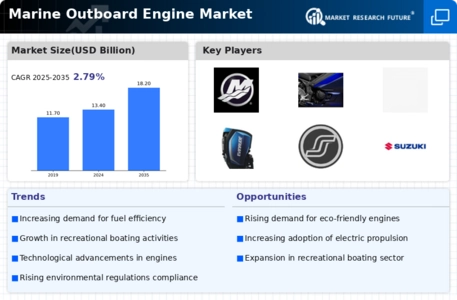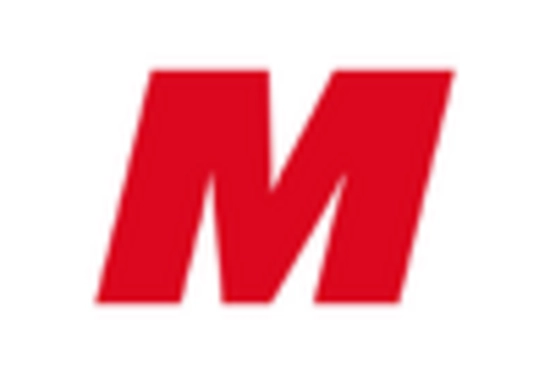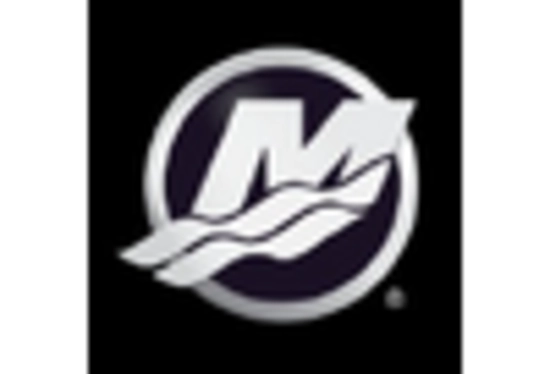Increasing Environmental Regulations
The Marine Outboard Engine Market is significantly influenced by the tightening of environmental regulations aimed at reducing emissions and promoting sustainability. Governments across various regions are implementing stricter standards for marine engines, compelling manufacturers to innovate and produce cleaner, more efficient outboard engines. This regulatory landscape is driving the development of engines that utilize alternative fuels and advanced technologies to minimize environmental impact. As a result, the market is witnessing a shift towards eco-friendly solutions, which not only comply with regulations but also appeal to a growing segment of environmentally conscious consumers. The emphasis on sustainability is likely to shape the future of the Marine Outboard Engine Market, as companies adapt to meet these evolving standards.
Rising Recreational Boating Activities
The Marine Outboard Engine Market is experiencing a notable surge in demand due to the increasing popularity of recreational boating activities. As more individuals seek leisure and adventure on water, the need for reliable and efficient outboard engines has escalated. Recent data indicates that the recreational boating sector has expanded significantly, with millions of new boat registrations annually. This trend is likely to continue, as consumers increasingly prioritize outdoor activities and water sports. Consequently, manufacturers are focusing on developing advanced outboard engines that cater to this growing market segment, enhancing performance and user experience. The rise in recreational boating not only drives sales but also encourages innovation within the Marine Outboard Engine Market, as companies strive to meet the evolving preferences of consumers.
Emerging Markets and Economic Development
Emerging markets are playing a crucial role in the expansion of the Marine Outboard Engine Market. As economies develop and disposable incomes rise, more consumers in these regions are investing in recreational boating and fishing activities. This trend is particularly evident in regions where access to water bodies is abundant, leading to increased demand for outboard engines. Furthermore, the growth of tourism in coastal areas is contributing to the market's expansion, as businesses seek to cater to tourists with boating experiences. Manufacturers are recognizing the potential of these emerging markets and are tailoring their products to meet local preferences and price points. The economic development in these regions is likely to drive sustained growth in the Marine Outboard Engine Market, creating new opportunities for both established and new players.
Technological Advancements in Engine Design
Technological advancements play a pivotal role in shaping the Marine Outboard Engine Market. Innovations in engine design, such as lightweight materials and improved fuel injection systems, are enhancing performance and efficiency. Recent developments have led to the introduction of engines that offer higher power outputs while consuming less fuel, appealing to environmentally conscious consumers. Furthermore, the integration of smart technologies, such as digital monitoring systems, is becoming increasingly prevalent. These advancements not only improve the overall user experience but also contribute to the longevity and reliability of outboard engines. As manufacturers continue to invest in research and development, the Marine Outboard Engine Market is poised for further growth, driven by the demand for cutting-edge technology and enhanced performance.
Growth in Commercial Fishing and Marine Transportation
The Marine Outboard Engine Market is benefiting from the growth in commercial fishing and marine transportation sectors. As global demand for seafood continues to rise, the need for efficient and reliable outboard engines in fishing vessels is becoming increasingly critical. Additionally, the marine transportation industry is expanding, with more businesses seeking to enhance their logistics capabilities through water-based transport. This growth is driving demand for high-performance outboard engines that can withstand rigorous operational conditions. Manufacturers are responding by developing engines that offer durability, fuel efficiency, and advanced features tailored to the needs of commercial operators. The expansion of these sectors is likely to sustain the momentum of the Marine Outboard Engine Market, presenting opportunities for innovation and market penetration.


















Leave a Comment